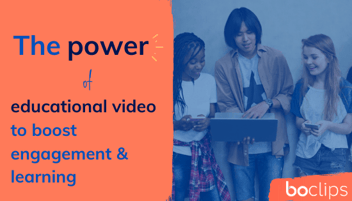Repeated studies have shown that quality educational videos of appropriate lengths are one of the most effective and universally accessible uses of technology in any classroom.
The Struggle Is Real
It would be nice if there were one single “right way” to teach. It would work with all students at all levels and across the curriculum, regardless of how long that particular teacher had been in the classroom and no matter what his or her personal strengths or weaknesses might be. Student achievement would go through the roof, and the savings on supplies and training would be incalculable.
Unfortunately, that does not seem to be the case. Students are simply too different and each teacher’s unique strengths simply too important. Even so, there are from time to time new technologies or resources which come as close as anything to proving themselves universally effective–the first-time teachers were provided with access to the Internet, for example, or presentation software, like PowerPoint. These were paradigm-shifting moments and now it would seem ridiculous for any district to be without either.
We’re in the middle of another shift right now, although precisely what it will look like coming out the other side is difficult to predict. Technology is changing what’s possible in education; the trick is figuring out which parts we actually want changed and which ones we don’t.
Some educators are simply excited just to be able to do a Jeopardy-style review on the smartboard. Others yearn for completely automated, individualized learning stations of some sort. If nothing else, we keep hoping that replacing textbooks with laptops or other one-to-one devices will do... something.
<<Want to learn more about how you can amplify great teaching with video? Schedule a demo>>
What Do We Know?
What is clear is that effective use of technology in the classroom matters. Good teachers, given relative autonomy, certainly matter more, but good teachers tend to incorporate technology effectively—making the distinction largely moot. The willingness of educators to get creative with the tools at their disposal keeps their classrooms fresh and engaging, while the essential skills and content students need remain the primary focus. The best uses of technology, in other words, usually serve the curriculum and the pedagogy—not the other way around.
It’s equally clear that teachers land all across the spectrum when it comes to their comfort level with technology. While some are creating their own apps or using the latest ed-tech to revolutionize their teaching every week or so, others are finally getting the hang of the online gradebook and how to take attendance. Districts wanting to incorporate more technology have to weigh any necessary training and the likelihood of their latest purchases actually being used regularly in multiple classrooms—not to mention possible pushback from teachers who may not be sold on the latest tech or share the priorities of those making the decisions—against the potential benefits to students and how cool it will be to talk about at the next board meeting.
It’s not always an easy decision.
There’s certainly a worthwhile debate to be had over the role of cutting-edge ed-tech in the classroom and the extent to which it can or should be utilized, let alone required. In the meantime, however, there’s also at least one paradigm-shifting classroom technology which is already nearly universal and ridiculously easy-to-use, even for the most resistant of educators. It’s been repeatedly shown to increase student learning and has a pushback factor of approximately zero percent.
The use of content-rich educational videos can be an effective addition to almost any classroom unit at any grade level and for almost any subject.

Why Video?
Kids are already watching videos of one sort or another. The percentage of 8- to 12-year-olds who report watching videos online every day has more than doubled in the past four years, from 24% in 2014 to 56% in 2019 (source). Teenagers are watching even more often. The percentage who say they watch online videos every day has jumped from 34% in 2015 to 69% this year.
When this trend has been harnessed for educational purposes, the results have been rather amazing. Multiple studies indicate that the use of regular, short (5—10 minutes each) educational videos increases student engagement and understanding (source). The ability to pause and discuss or re-watch videos is differentiation in its purest form and allows students to process at their own rate and in their own way. Both qualitative feedback and quantitative results show marked improvement in both test scores and student belief in their own ability to learn—to advance in both skills and knowledge.
For those not as enamored with online videos, it may be difficult to accept their effectiveness when used for education instead of mere distraction or entertainment. And yet, study after study says that they work. How can this be?
- Create a richer, more stimulating educational experience. Educational videos create a more engaging sensory experience than print materials. Learners can see and hear the concepts being taught in much the same way as they would everyday interactions. The combination of verbal explanations, supporting text, and moving visuals is richer than even the best textbook can provide.
- Take students on impossible field trips. Educational videos allow students to “go” anywhere it’s possible to represent on the screen—into the human colon, off to the furthermost reaches of space, back in time to the French Revolution, or to each and every gallery in the Louvre. They’re the next best thing to being there.
- Simplify the complex—at each student’s own pace. Educational videos allow step-by-step explanations of complex concepts at each student’s individual pace. The ability to pause, look up terminology, examine visuals, or otherwise digest complicated material allows every student to take as much (or as little) time as they need without the rest of the class being held captive to their pace.
- Convey more, faster. You’ve heard that a picture is worth 1,000 words. According to Forrester Research, one minute of video is worth around 180,000 pictures, or 1.8 million words (source). Even if we err on the side of caution and cut that figure by 90%, the average 10-minute education video is still worth over a dozen textbooks—yet costs substantially less.
- Break down learning in bite-sized chunks. Educational videos of 10 minutes or less help to segment the larger lesson, whether they’re shown in class or assigned for home. As any educator in the 21st century can tell you, today’s students do better when learning is broken into “chunks.” Even a one-hour class period is often more effective if divided into two or three related activities. Videos are a new “chunk” each time, and research shows that nearly 100% of students will remain focused on educational videos of 10 minutes or less.
- Play, learn, repeat. Educational videos increase knowledge retention. If you remember reading that just above only moments ago, then you’ve just experienced part of why this is. The repetition of repeated viewing available to students—either immediately in order to better understand, or weeks later in order to review—supports that most basic of pedagogical truisms: repetition, repetition, repetition. Add to this their multimodal nature and the deeper engagement already discussed and we have a winner!
I Can’t Get No (Teacher) Satisfaction
None of these results are news to the vast majority of classroom teachers, many of whom are already doing their best to incorporate educational videos effectively. Unfortunately, it’s a task which often proves itself more complicated and time-intensive than it would initially seem.
The biggest challenge is simply finding the right material. More often than not this means browsing YouTube or other online video libraries for hours, trying variations on search terms and hoping for the best. Much of what can be found this way is of questionable quality; it’s poorly produced, it doesn’t quite cover the intended content, or—worst of all—it’s just… boring. What’s almost more disheartening is discovering high-quality content which is well-designed, engaging, and rich in content, but isn’t intended for academia. The literary analysis may be stellar, the historical coverage insightful and pithy—but the language and visuals simply too R-rated for classroom use.
Even when teachers find something they like, it’s impossible to control the number or type of ads which pop up before—and often in the middle of—each viewing. It doesn’t help that, online resources being what they are, it’s impossible to predict if it will still be there next time it’s needed. In short, relying on the online options currently available is too time-intensive to effectively utilize regularly.
Imagine offering teachers the largest online library of short-form education videos, searchable by grade level, subject matter—even length—and completely free of ads or inappropriate content. It would be good for kids, but they wouldn’t hate it. It would be easy for teachers to use without requiring hours of training; they may even be thankful. Such a solution already exists: Boclips for Teachers, a video platform designed by teachers, for teachers, which makes it easy and efficient to tap into the power of high-quality educational video in the classroom.
Just to keep things as accessible and user-friendly as possible, it also includes lesson plans and activities, teacher ratings for each video, and suggestions on effective usage and other teacher insights.
For educators already comfortable using technology, the possibilities are endless. For those who are less technology-driven, Boclips for Teachers can be a non-threatening, impossible-to-mess-up introduction to ed-tech and its potential in the classroom. For school districts, it’s an affordable, practical way to provide resources for your teachers while still maintaining some control over media use in the classroom. (There’s no longer a good reason Ms. Stavinsky simply HAS to have unlimited access to YouTube.)
It’s not every day we have a chance to do something that improves student learning, makes teachers happy, and doesn’t bankrupt the district along the way. Let’s talk about what we can do to make it happen this time.
Sources
https://www.commonsensemedia.org/sites/default/files/uploads/research/census_researchreport.pdf
https://www.cisco.com/c/dam/en_us/solutions/industries/docs/education/ciscovideowp.pdf
https://techxplore.com/news/2019-10-survey-kids-appetite-online-video.html
Boclips
Boclips is on a mission to make learning more captivating with video with an easier, safer way to access videos from the world’s leading video producers.
- #Classroom
- #Video in Digital Learning
- #Educational Videos
- #Tips for Using Video
- #Video Content Partners
- #Boclips for Publishers
- #Issues in Education
- #Educational Videos by Subject Area
- #News and Announcements
- #Events & Holidays
- #Video and Teaching Tools
- #Teaching Methodologies
- #Education Videos
- #Video and Digital Literacy
- #Short Educational Videos
- #Instructional Design
- #Multimodal Learning
- #Video and Student Safety
- #Accessibility in Education
-3.png?width=390&height=223&name=Untitled%20design%20(2)-3.png)


.png?width=1152&height=660&name=Copy%20of%20Untitled%20Design%20(1).png)




